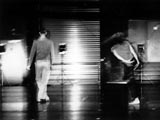Pop-Up Songbook
1999
Thomas Hauert in an interview with Marianne Van Kerkhoven (Kaaitheater) :
In Pop-Up Songbook we worked with voices; voices that sing songs, which explains the word ‘song’ in the title; we called it a songbook because the performance consists of a collection of short pieces which, although they are connected, also stand alone: a concert, a book of songs. ‘Pop-up’ refers to those books in which the figures unfold as you open them and become three-dimensional. The soundtrack, made by Bart Aga and Alex Fostier, consists of a recording of our own voices electronically manipulated and sampled. At several points in the performance our live voices are processed directly through the computer and distorted. The words and the content of the songs (about love, the beauty of the world) are not so important, it is more a question of their materiality, their sound.
For Pop-Up Songbook we were looking primarily for the relationship between voice and body: how does one use one’s voice? Into what state do you get your body in order to achieve the best resonance? As performers we are used to standing on a stage, but we are not professional singers; most of all we have sought out our own honest, authentic vocal sound, our ‘naked’ voice: we do not hide behind a dramatic character but show ourselves as we are, our direct personalities.
Just as in my previous group project Cows in Space, in Pop-Up Songbook we are again using a combination of strictly structured movement material and improvised movements. We do not see improvisation only as a tool to be used during rehearsals; it is also integrated into the performances themselves. This is because I am convinced that by way of improvisation the body can arrive at very complex patterns of movement, which one would never be able to think of in isolation beforehand. In improvisation one has to dare to go all the way, past the boundary where you repeat ‘habitual’ movements your body knows.
As far as structure is concerned, we have worked on the principle of parallel lines; after all, in addition to each dancer’s individual movements one works with their relationships with each other; the group becomes a sixth body; just as the orbits of heavenly bodies are related to each other. We have developed these parallel lines in twelve directions based on the twelve figures of the clock. The dancers choose different directions on this basis: so the form and the formation of the whole group is constantly changing. There is also a section in which we work with balance and gravity by standing on one leg for a long time. We are reinvesting in this piece the material we found for Cows in Space by examining the kinetic possibilities of each joint in our bodies: what joint movements are possible when you are standing on one leg?
In my research I also still want to make the space between the dancers visible, to create a magnetic field between them, as if there were a supple moving body between them. This should penetrate into the viewer’s perception. From the beginning of my choreographic work – even when I was still at school in Rotterdam – I was working on linking together, for example, an equilateral triangle, a square and a circle in the path followed by the dancers; that led to a strange, fascinating effect, a ‘layer’ that inserted itself under the choreography. In my Rosas period (Hauert worked on the creations of Erts, Mozart Concert aria’s and Kinok with Anne Teresa De Keersmaeker) I also worked on the path followed by the people in Dziga Vertov’s film The Man with the Camera and I tried to reconstruct it on stage.
My work is research-oriented. The work on the voice we have started in Pop-Up Songbook will definitely be explored in greater depth in a later project. As well as this I also want to look into the dramatic content of the quality of movement, and the theatricality of the physical side.
Concept & direction Thomas Hauert
Choreography, dance & singing Sara Ludi, Mark Lorimer, Mat Voorter, Samantha van Wissen, Thomas Hauert
Set & lightdesign Simon Siegmann
Original music & sound design Bart Aga & Alex Fostier
Voice coaching Rahel Studer
Production ZOO/Thomas Hauert
Coproduction Springdance, Utrecht (NL)
Supported by: Ministerie van de Vlaamse Gemeenschap / Vlaamse Gemeenschapscommisie / Pro Helvetia / SACD (Program “1500 hours to dance”) / Rencontres chorégraphiques internationales de Seine-Saint-Denis
Thanks to Kaaitheater, Nathalie Douxfils, Pascale Gigon, Aliocha Van der Avoort, Cie. Pierre Droulers and Dirk Bikkembergs



